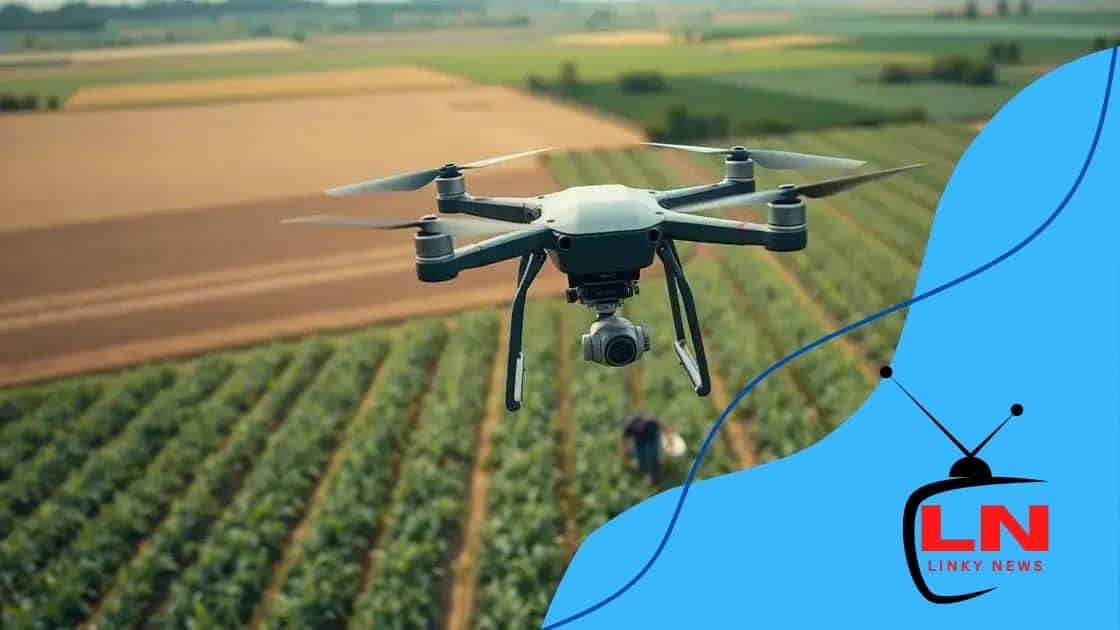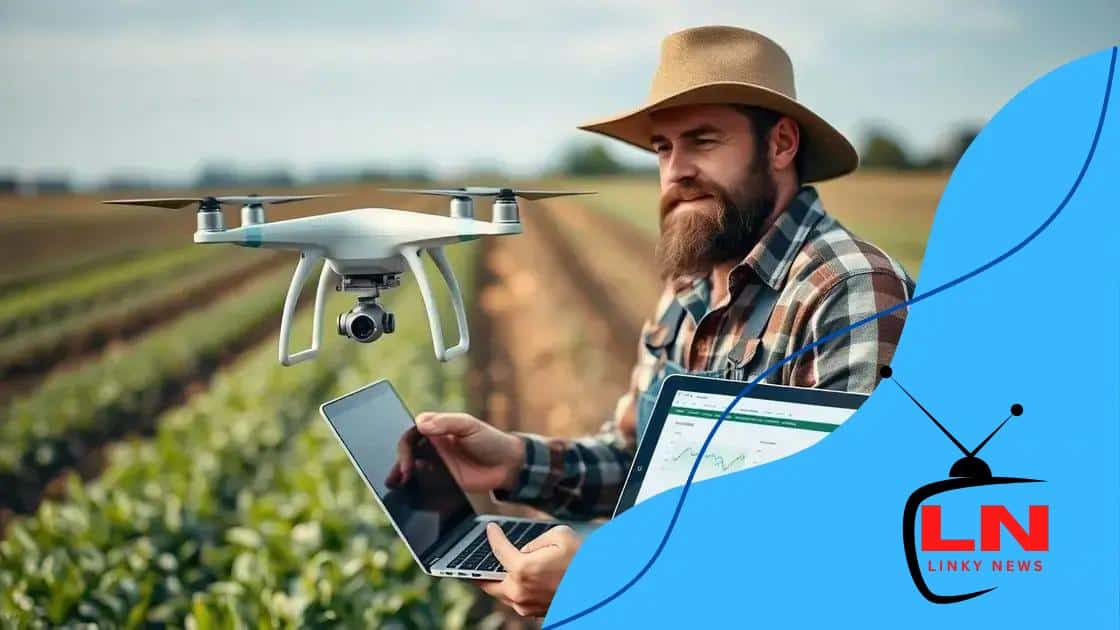Drones in agriculture management: transforming farming practices

Drones in agriculture management significantly enhance efficiency and productivity by providing real-time data, enabling farmers to make informed decisions and optimize resource usage for sustainable farming practices.
Drones in agriculture management are changing the landscape of farming, offering innovative solutions for crop monitoring and resource management. Have you ever wondered how technology can boost your farm’s productivity?
How drones are enhancing crop monitoring
In recent years, drones have become a game-changer in agriculture, especially in crop monitoring. These flying devices allow farmers to keep an eye on their fields more effectively and efficiently. By capturing detailed images from the sky, drones provide insights that were once difficult to obtain.
Improved Data Collection
Drones collect and transmit real-time data that informs decisions. This data includes information on plant health, soil conditions, and moisture levels.
- High-resolution aerial imagery
- Thermal imaging for temperature analysis
- Multispectral data for assessing plant health
With this information, farmers can respond quickly to any issues that arise. For example, if a section of a field is underperforming, it can be addressed before it affects overall yield.
Cost Efficiency
Using drones for monitoring is often more cost-effective than traditional methods. Rather than manually inspecting crops, which can be time-consuming and labor-intensive, drones can cover large areas in a fraction of the time.
This increased efficiency saves farmers both time and money, allowing them to allocate resources more effectively. Furthermore, the data collected can lead to better decision-making, maximizing yield potential.
In addition to saving time and costs, drones facilitate precision farming. By targeting specific areas that require attention, farmers can optimize their inputs and reduce waste, benefitting the environment as well.
Moreover, when combined with advanced analytics, the data gathered by drones can predict trends and identify patterns over time. This information helps farmers plan for seasonal changes and maximize their crop productivity.
In summary, drones are enhancing crop monitoring by providing accurate, timely data and promoting more efficient farming practices. Their ability to collect diverse information, coupled with lower costs and improved decision-making, makes them an invaluable tool in modern agriculture.
The benefits of using drones in farming
The use of drones in farming has brought numerous advantages that transform traditional agricultural practices. These high-tech tools offer innovative ways to enhance productivity and efficiency on farms of all sizes.
Increased Efficiency
Drones can cover large areas of land in a short amount of time, allowing farmers to conduct surveys and monitor crops without the need for manual labor. This efficiency allows for more immediate data collection and analysis.
- Fast aerial assessments
- Reduction in manpower needed
- Time-saving in operations
This means farmers spend less time worrying about logistics and more time on strategic planning for their agricultural production.
Cost Reduction
Adopting drones can significantly lower farming costs. Traditional methods of monitoring crops often involve expensive equipment or labor costs. Drones provide a cost-effective alternative by simplifying the data collection process.
The ability to quickly identify problem areas in crops allows for targeted interventions, which can save resources and improve overall profitability. Instead of treating entire fields, farmers can focus on specific zones that need attention.
With this targeted approach, inputs like fertilizers and pesticides can be used more efficiently, reducing waste and decreasing chemical runoff into the environment.
Data Precision
One of the standout features of drones is their ability to capture detailed images and data. They can provide real-time insights, offering farmers precise information about their crops’ health, moisture levels, and growth patterns.
This data enables better decision-making, which is crucial for maximizing crop yield. Understanding specific needs helps farmers to improve their agricultural practices continuously.
Moreover, the integration of data analytics with drone technology opens doors for predictive insights and long-term planning. Farmers can analyze trends to improve future farm management and enhance sustainability.
Overall, drones enhance farming practices in various ways, from efficiency to cost savings and data precision. These benefits make them a powerful tool for modern agribusiness.
Implementing drone technology in your farm management

Implementing drone technology in your farm management can significantly elevate agricultural efficiency. Many farmers are now adopting this innovative tool to streamline their operations effectively.
Choosing the Right Drone
The first step is selecting the appropriate drone that suits your farm’s needs. Different drones come with various features tailored for specific tasks.
- Fixed-wing drones for large fields
- Multirotor drones for precise applications
- Hybrid options offering the best of both styles
Understanding these options can help farmers make informed decisions that align with their operational requirements.
Training and Setup
Once you choose a drone, proper training is essential. Farmers should engage in training programs to learn how to operate drones effectively.
Getting familiar with the software that processes the data collected is equally important. Regular practice ensures that you can maximize the data’s benefits.
In addition, setting up your drone involves calibrating it according to your field’s specific geography. This setup will enable your drone to gather accurate and useful data.
Data Management
After flying the drone and collecting data, managing this information becomes crucial. Farmers should invest in analytics software tailored for agricultural data.
This software can help interpret the data, revealing insights about crop health, soil conditions, and moisture levels. By analyzing the gathered data, farmers can identify trends that inform their decisions.
This insight ultimately supports better crop management and resource allocation. Effective data management directly contributes to increased yields and sustainability.
Incorporating drone technology into farm management not only enhances operational efficiency but also strengthens the decision-making process. From choosing the right drone to implementing effective analytics, each step plays a vital role in modern farming practices.
Challenges faced while using drones in agriculture
While drones offer many benefits for agriculture, their use also comes with challenges that farmers must address. Understanding these issues is essential for effective implementation in farm practices.
Regulatory Hurdles
One of the primary challenges is navigating the various regulations in different regions. Rules regarding drone usage often vary significantly and can be complex.
- Permits required for commercial use
- Restricted airspaces over certain fields
- Weight and size limitations imposed by law
Farmers must ensure compliance with local regulations, which can sometimes be overwhelming and may delay the adoption of drone technology.
Technical Limitations
The technology behind drones is continually evolving, but there are still limitations. For instance, battery life can restrict flight time, especially over large fields. Frequent recharging can interrupt monitoring tasks and reduce efficiency.
Additionally, weather conditions can pose significant challenges. Rain, strong winds, or even extreme heat can affect flight stability and data quality. This inconsistency can complicate data collection efforts.
Data Overload
As drones collect vast amounts of data, managing this information becomes a challenge. Farmers must be prepared to analyze and interpret complex data sets.
Without proper data management tools, making sense of the information can be difficult. This can lead to missed opportunities or delayed interventions, impacting crop health and yield negatively.
Moreover, the need for skilled personnel to analyze data might require farmers to invest in additional training or hire new staff, further complicating the situation.
In conclusion, drones bring innovative solutions to agriculture, but they also face numerous challenges. From regulatory hurdles and technical limitations to data management issues, farmers must be prepared to address these obstacles to fully harness the benefits of drone technology in their operations.
The future of drones in agriculture management
The future of drones in agriculture management looks incredibly promising. As technology continues to evolve, farmers can expect even more innovative applications that enhance productivity.
Advancements in Technology
Emerging technologies, like artificial intelligence (AI) and machine learning, are set to further improve drone capabilities. These advanced systems will enable drones to analyze data more quickly and provide actionable insights.
- Improved image processing for crop health analysis
- Automated flight paths for precision agriculture
- Real-time data sharing between drones and farmers
These advancements are likely to enable farmers to respond to issues promptly and optimize their practices effectively.
Integration with Other Technologies
In the future, we can expect drones to work alongside other technologies, like Internet of Things (IoT) devices. This will create a more connected farm environment, where data circulates seamlessly.
Drones can gather information that IoT sensors collect in the field, enhancing decision-making. For example, drones might identify irrigation needs based on soil moisture data provided by sensors.
Sustainability and Environmental Impact
As sustainability becomes a priority, drones could play a crucial role in minimizing environmental impact. Using drones for precise applications could reduce the use of chemicals in farming.
Farmers can apply fertilizers and pesticides only where necessary, which not only cuts costs but also benefits the environment. This approach helps protect soil and water resources, promoting sustainable farming practices.
Furthermore, with enhanced monitoring, farmers can adapt to climate changes more effectively, ensuring food security for future generations.
The future of drones in agriculture management is bright, with potential innovations leading to increased efficiency, sustainability, and better crop yields. By embracing these advancements, farmers can significantly enhance their operations.
FAQ – Frequently Asked Questions about Drones in Agriculture
What benefits do drones offer for farm management?
Drones enhance efficiency, provide real-time data, and help farmers make informed decisions, ultimately boosting crop yields.
How do drones help with sustainability in farming?
Drones allow for precise application of fertilizers and pesticides, reducing chemical use and minimizing environmental impact.
What challenges do farmers face when implementing drones?
Farmers often deal with regulatory hurdles, technical limitations such as battery life, and the need for effective data management.
How is drone technology expected to evolve in the future?
Future advancements may include improved AI capabilities, better integration with IoT devices, and enhanced data analytics tools for farmers.





